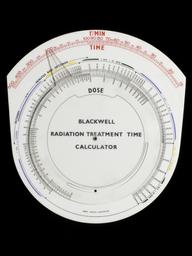

Radiation protection gloves
- Made:
- 1920-1958 in unknown place




Pair of lead gloves, for use as protective for X-ray technician, 1920 to 1958
A layer of lead incorporated into these gloves helps protect an X-ray technician from harmful radiation. They became standard protective equipment. The gloves are made of cloth. With the lead, they weigh three kilos. They are seen with a protective apron (A606875). This is also lead lined.
X-rays were discovered in 1895 by Wilhelm Conrad Röntgen (1845-1923). The first committee to investigate possible ill effects of X-rays was formed three years later in 1898. Reports of burns and dermatitis due to the rays were frequent by this date.
Details
- Category:
- Radiomedicine
- Collection:
- Sir Henry Wellcome's Museum Collection
- Object Number:
- A606876
- Measurements:
-
overall: 30 mm x 340 mm x 135 mm, 2.418 kg
- credit:
- Mann, J.J. and Kohnstamm




